|
Deer & Rabbits of AmericaOrganically Controlling These Garden DestroyersWhat do you want to learn about?
Rabbits
Rabbits Spread Disease!!!
|
| Type of Plant | Seldom Damaged | Moderately Damaged | Heavily Damaged |
| Woody | Japanese Maple Butterfly-bush Boxwood Smooth Hydrangea Sweet Gum Tulip Tree Blue Spruce White Pine Rhododendron Azaleas |
Smoke Bush Roses |
Barberry Eastern Redbud Japanese Floweringquince Hawthorn Winged Euonymus Forsythias Rose of Sharon Flowering Crabapple Roses Lilac |
| Vines | Trumpet vine Clematis |
Clematis Morning Glory |
|
| Fruits | Raspberry Blackberry |
Kiwi Strawberry Apples Grimes Golden Yellow Delicious Pear Blackberry & Raspberry Blueberry |
|
| Perennials |
Daylily Hyacinth Columbine Moss Phlox Perennial Salvia Autumn Joy Sedum Lambs Ear |
Pinks Purple Coneflower Plantain Lily |
Pink Coreopsis Purple Coneflower Baby's Breath Coral Bells-flowers only Plantain Lily Oriental Poppy Garden Phlox Black-eyed Susan Pincushion Flower Vervain |
| Annuals | Ageratum Wax Begonia Vinca Spider Flower Four-O’Clock Geranium |
Petunia Marigold Mexican Sunflowers |
Snapdragon Cockscomb Cosmos Sunflower Impatiens Petunia Rose Moss Garden Verbena Pansy Zinnas |
| Bulbs | Gladiola Grape Hyacinths |
Crocus Dutch Hardy and Asiatic Tulip |
|
| Vegetables | Onion Asparagus Summer Squash Tomato Rhubarb Potato |
Cucumbers Peppers |
Beets Swiss Chard Broccoli Peppers Lettuce Beans Peas Spinach |
What
rabbits NEVER eat...
| Type of Plant | Never Damaged |
| Perennials | Sage Cacti Hardy Geraniums Lavender Daffodils Oregano Rosemary Salvia Marigold Yucca Spiraea |
Organic Rabbit Control
Rabbits will eat your entire garden if you let them. It is always
best to use organic repellents to deter these animals because
chemical products can be life threatening for pets, children, or
other wildlife that you are not intending to harm. Organic rabbit
repellents work just as well as their chemical counterparts. Most
rabbit repellents are either a spray or a granular substance that
taste or smell bad to the rabbit. Below are a few
products that can help control and maintain your yard from these
pesky animals without the worry harming anything. Just click on a
product to learn more about it or if you want to purchase it.
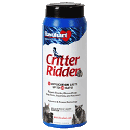 |
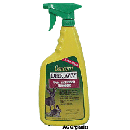 |
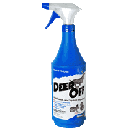 |
||
| Critter Ridder | Deer Away | Deer Off |
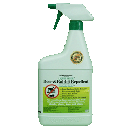 |
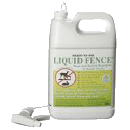 |
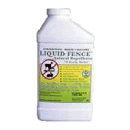 |
||
| Liquid Fence Spray Quart | Liquid Fence Spray Gallon | Liquid Fence Concentrate |
Deer
Where they come from and what
they do...
Deer are probably the most widely distributed and best-recognized
large mammals in North America. The white-tailed deer is found
throughout much of North America. It is found in every state in the
United States except perhaps Alaska and Utah. It occurs throughout
the southern provinces of Canada, across the United States, and on
into Central and South America.
Deer normally graze on grasses, weeds, vegetables, flowers,
ornamental and fruiting shrubs, and browse—the leaves, twigs, and
small branches of trees and shrubs. Deer damage is easily recognized
because, lacking upper front incisors, deer can only grind and chew
with their molars. Leaves and twigs are ripped from trees and brush
leaving a ragged surface. Annuals may be pulled out of the ground.
Damage to larger trees extends only to eight feet, the highest they
can reach. Smaller trees can be pushed down and totally destroyed or
the bark may be chewed through, causing the tree to die. If deer are
hungry enough, they will eat almost any plant. Deer can also be
identified by their tracks or their excrement (scat). Deer hooves
are cloven into two halves.
Rabbits have a hard time digesting their food, so in order to solve
this problem rabbits pass two distinct types of feces: hard
droppings and soft black viscous pellets, the latter of which are
immediately eaten. Rabbits re-ingest their own droppings in order to
fully digest their food and extract sufficient nutrients.
Characteristics…
The average whitetail stands between 36 and 40 inches high at the
top of the shoulder. Especially big bucks may be 42 inches high.
They have a total length of between 60 to 75 inches and an average
weight of about 150 pounds. Deer live in a matriarchal society. The
bucks live separately from the does and their offspring except
during the breeding season and part of the winter. Even when the
bucks are with the herd, they do not take over the lead but are led
by an old doe.
Deer are creatures of habit. If unmolested, they follow the same
routine, the same trails, day after day, shifting the pattern only
because of weather conditions and the availability of food. Deer can
smell an enemy long before it is in sight or can be heard. Deer are
selective feeders. They are usually browsers, and primarily feed on
leaves. They have small, unspecialized stomachs by ruminant
standards, and high nutrition requirements. Rather than attempt to
digest vast quantities of low-grade, fibrous food as, for example,
sheep and cattle do, deer select easily digestible shoots, young
leaves, fresh grasses, soft twigs, fruit, fungi, and lichens.
![]() Making Babies…
Making Babies…
 Females enter estrus, colloquially called the rut, in the
fall, normally in late October or early November, triggered
mainly by declining photoperiod. Sexual maturation
of females depends on population density. Females can mature
in their first year, although this is unusual and would
occur only at very low population levels. Most females
mature at one or, sometimes, two years of age. Males compete
for the opportunity of breeding females. Sparring among
males determines a dominance hierarchy. Bucks will attempt
to copulate with as many females as possible, losing
physical condition since they rarely eat or rest during the
rut. The general geographical trend is for the rut to be
shorter in duration at increased latitude. Females give
birth to one, two or even possibly three spotted young,
known as fawns in mid to late spring, generally in May or
June. Fawns lose their spots during the first summer and
will weigh from 44 to 77 pounds (20 to 35 kg) by the first
winter. Male fawns tend to be slightly larger and heavier
than females.
Females enter estrus, colloquially called the rut, in the
fall, normally in late October or early November, triggered
mainly by declining photoperiod. Sexual maturation
of females depends on population density. Females can mature
in their first year, although this is unusual and would
occur only at very low population levels. Most females
mature at one or, sometimes, two years of age. Males compete
for the opportunity of breeding females. Sparring among
males determines a dominance hierarchy. Bucks will attempt
to copulate with as many females as possible, losing
physical condition since they rarely eat or rest during the
rut. The general geographical trend is for the rut to be
shorter in duration at increased latitude. Females give
birth to one, two or even possibly three spotted young,
known as fawns in mid to late spring, generally in May or
June. Fawns lose their spots during the first summer and
will weigh from 44 to 77 pounds (20 to 35 kg) by the first
winter. Male fawns tend to be slightly larger and heavier
than females.
Did
You Know?
![]() Deer do not have any teeth in
the front of the upper jawbone.
Deer do not have any teeth in
the front of the upper jawbone.
![]() Deer
need 10 to 12 pounds of food per day to satisfy their needs.
Deer
need 10 to 12 pounds of food per day to satisfy their needs.
![]() A
deer can clear an 8-foot hurdle from a standing position.
A
deer can clear an 8-foot hurdle from a standing position.
What
Deer Love to Eat...
| Type of Plant | Heavily Damaged |
| Trees | Red Maple White Cedar White Acorns Apples Dogwood Sweetfern Oak Willow Wintergreen Pine |
| Cultivated Crops | Corn Alfalfa Clover Cabbage Rape Soybeans Rye Lespedeza Trefoil |
| Perennials | Cactus Lily-of-the-Valley Most Ferns Daylily Siberian Iris Lavender Ornamental grasses Creeping Phlox Perennial Salvia Sedum Lamb's Ear |
| Annuals | Mexican Ageratum Wax Begonia Amethyst Flower Marigold Vinca Spiderflower Four O'clock Geranium |
| Bulbs | Persian Onion Hyacinth Daffodils |
| Vegetables | Onions Leeks Asparagus Summer Squash Tomato Rhubarb Potatoes |
| Herbs | Tarragon Marjoram Mint Basil Oregano Parsley Savory |
Organic Deer Control
Deer cause many problems to your landscaping. They can eat or rub all the bark off of your trees
and eat your plants. Feeding deer attracts more deer than can be fed and adds to
landscape damage. Deer can eat all of your plants in just one night,
so it is essential to use preventative measures against them. There
are organic products that you can spray on your plants to make your
flower bed taste and smell horrible to the deer. Below are a few
products that can help control and maintain your yard from these
pesky animals without the worry harming anything. Just click on a
product to learn more about it or if you want to purchase it.
 |
 |
 |
||
| Critter Ridder | Deer Away | Deer Off |
 |
 |
 |
||
| Liquid Fence Spray Quart | Liquid Fence Spray Gallon | Liquid Fence Concentrate |
|
Testimonials Product: Liquid Fence Deer & Rabbit
Repellent Product: Liquid Fence Deer & Rabbit
Repellent Product: Deer Off |
About Us
We
strive to offer our customers the absolute best service to accompany
the highest quality products. Everything you buy has a money back
guarantee if you are not satisfied. Right now we carry a large
variety of organic insecticides and fertilizers, but we are
expanding to multiple lines of "natural living." For more information on
rabbits and deer or other home and garden pest, visit us at
www.IamOrganic.com.
Have a Question?
Email us ANY question you have about our products or problems
you are having around your home.
We are here to help...
Support@IamOrganic.com
Like this Website???
Check out our others:
Informational Sites:
http://www.mouse-rat.com/
http://www.flea-control.org/
http://www.agturfproducts.com/
Blogs:
http://www.iamorganic.com/blog/index.php
http://iamorganic.wordpress.com/
Product Websites:
http://www.IamOrganic.com
http://www.Organic-Gardening-Shop.com
http://www.AgOrganics.com


 Rabbits can have babies at age 6 months old. They can have 20 to 40
babies a year. Litters of 3 to 7 young are produced, at five-week
intervals, from January to late summer. Newborn rabbits are naked,
blind, and helpless at birth. Mothers are remarkably inattentive to
their young and are almost absentee parents, commonly nursing their
young only once per day and for just a few minutes. To overcome this
lack of attention, the milk of rabbits is highly nutritious and
among the richest of that of all mammals. The young grow rapidly,
and most are weaned in about a month. Males (bucks) do not assist in
rearing the kittens. The mother rabbit is able to become pregnant
again 4 days after the birth of her kittens.
Rabbits can have babies at age 6 months old. They can have 20 to 40
babies a year. Litters of 3 to 7 young are produced, at five-week
intervals, from January to late summer. Newborn rabbits are naked,
blind, and helpless at birth. Mothers are remarkably inattentive to
their young and are almost absentee parents, commonly nursing their
young only once per day and for just a few minutes. To overcome this
lack of attention, the milk of rabbits is highly nutritious and
among the richest of that of all mammals. The young grow rapidly,
and most are weaned in about a month. Males (bucks) do not assist in
rearing the kittens. The mother rabbit is able to become pregnant
again 4 days after the birth of her kittens.